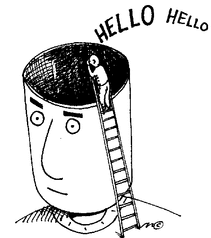Cognitivism
Cognitivism focuses on the mind, and more specifically, mental proceses such as thinking, knowing, memory, and problem-solving, with the goal of opening the “black box” of the human mind, the process of which is deemed valuable and necessary for learning to occur. Knowledge is approached as schema constructions, and learning is viewed as a change in the learner's schemata, or the redefining of prior knowledge.
Key Words (and Definitions)
- Schema Theory is defined as a mental representation of something previously known, including actions, events, and perspectives. These are the building blocks of knowledge.
- Gestalt Theory states that perceptions are entirely dependent upon the whole and not of the individual parts. All of our understanding is built upon whole objects, events and not of their small parts.
- Equilibrium is the state in which our minds exists before we learn something new. The process, called "adaption" by Piaget, flows as follows:
Equilibrium-->New Situation/Schema-->Disequilibrium-->Accomodation-->Assimilation
Applications in Educational Technology
|
The best way for a teacher to approach using cognitivism in the classroom is to ask questions to help students refine their thinking and recognize where they may be wrong. You want to approach topics that they may think they already know and introduce some new aspect to make them redefine something. Alternately, for entirely new topics, you want to draw upon background knowledge before you challenge existing ideas (schema) and create learning toward amplification or change of those schemata.
|
A quick video of an example in general
education using a cognitivist approach. |
Some great examples of Cognitivism in educational technology can be found in online games and reinforcement activities, such as sorting games, puzzles, and flashcards. These games will often present prior knowledge schema in a different method, thus creating disequilibrium and a need to adapt and learn the new information in order to continue. For example, the online resource Quizlet creates a means of listing vocabulary, pictures, and even mathematical procedures and then taking that list and producing several ways of practicing the previously known schemata, including the incorporation of audio and video.
Image Credits
Black Box of the Mind. Retrieved October 4, 2012 from:
http://thecognitivehorse.com/2012/07/24/if-a-horse-could-open-up-the-black-box-of-skinner/
Mind as Computer. Retrieved October 6, 2012 from:
http://www.leerbeleving.nl/wbts/1/didactical_models.html
http://thecognitivehorse.com/2012/07/24/if-a-horse-could-open-up-the-black-box-of-skinner/
Mind as Computer. Retrieved October 6, 2012 from:
http://www.leerbeleving.nl/wbts/1/didactical_models.html

